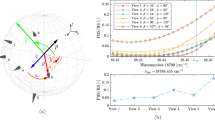Abstract
Laser-induced Rayleigh scattering makes use of the fact that elastically scattered laser light from atoms or molecules hold information on pressure, temperature and velocity inside the observed region of interest. Being several orders of magnitude weaker than other elastic light scattering effects such as Mie scattering from larger particles or laser flare from surfaces, the accuracy of Rayleigh scattering measurements strongly depends on the attenuation of these unwanted but omnipresent noise effects. The image-based technique of filtered Rayleigh scattering makes use of the absorption bands of atomic or molecular gases to remove strong elastic scattering effects from the measured signal. The concept is extended by frequency tuning a narrow line-width continuous wave laser light source along the absorption filter’s transmission profile. In acquiring images at several known frequencies, this results in spectra for each camera pixel from which time-averaged temperature, pressure and velocity fields can be deduced simultaneously. In order to qualify the frequency scanning filtered Rayleigh scattering technique for applications with strongly limited accessibility, it is applied to characterize the flow inside a bell-mouthed circular duct. The image data are acquired endoscopically via a fiberscope that is placed downstream from the measurement plane.













Similar content being viewed by others
References
Blevins R (1992) Applied fluid dynamics handbook. Krieger, Malabar
Boguszko M, Elliott G (2005) On the use of filtered Rayleigh scattering for measurements in compressible flows and thermal fields. Exp Fluids 38(1):33–49
Elliott GS, Glumac N, Carter CD, Nejad AS (1997) Two-dimensional temperature field measurements using a molecular filter based technique. Combust Sci Technol 125(1):351–369
Elliott GS, Glumac N, Carter CD (2001) Molecular filtered Rayleigh scattering applied to combustion. Meas Sci Technol 12(4):452
Forkey J (1996) Development and demonstration of filtered Rayleigh scattering: a laser based flow diagnostic for planar measurement of velocity, temperature and pressure. Ph.D. thesis, Princeton University
Forkey J, Finkelstein N, Lempert W, Miles R (1996) Demonstration and characterization of filtered Rayleigh scattering for planar velocity measurements: aerodynamic measurement technology. AAIAA J 34(3): 442–448
Forkey JN, Lempert WR, Miles RB (1997) Corrected and calibrated i2 absorption model at frequency-doubled nd:yag laser wavelengths. Appl Opt 36(27): 6729–6738
Gustavsson JPR, Segal C (2005) Filtered Rayleigh scattering velocimetry - accuracy investigation in a m=2.2 axisymmetric jet. Exp Fluids 38:11–20
Kearney SP, Schefer RW, Beresh SJ, Grasser TW (2005) Temperature imaging in nonpremixed flames by joint filtered Rayleigh and Raman scattering. Appl Opt 44(9):1548–1558
Miles R, Lempert W (1990) Two-dimensional measurement of density, velocity, and temperature in turbulent high-speed air flows by UV Rayleigh scattering. Appl Phys B Lasers Opt 51: 1–7
Miles R, Lempert W, Forkey J, Finkelstein N, Erbland P (1994) Quantifying high speed air flows by light scattering from air molecules. In: AIAA, Fluid Dynamics Conference, 25 th, Colorado Springs, CO
Miles RB, Lempert WR, Forkey JN (2001) Laser Rayleigh scattering. Meas Sci Technol 12(5): R33
Miles RB, Yalin AP, Tang Z, Zaidi SH, Forkey JN (2001) Flow field imaging through sharp-edged atomic and molecular notch filters. Meas Sci Technol 12(4):442
Most D, Dinkelacker F, Leipertz A (2002) Direct determination of the turbulent flux by simultaneous application of filtered rayleigh scattering thermometry and particle image velocimetry. Proc Combust Inst 29(2):2669–2677
Roehle I, Willert CE (2001) Extension of Doppler global velocimetry to periodic flows. Meas Sci Technol 12(4):420
Stolen RH, Ippen EP (1973) Raman gain in glass optical waveguides. Appl Phys Lett 22(6):276–278
Tenti G, Boley, C, Desai R (1974) On the kinetic model description of Rayleigh-Brillouin scattering from molecular gases. Can J Phys 52(4):285–290
Udovich JA, Kirkpatrick ND, Kano A, Tanbakuchi A, Utzinger U, Gmitro AF (2008) Spectral background and transmission characteristics of fiber optic imaging bundles. Appl Opt 47(25):4560–4568
Vetterling W, Flannery B, Press W, Teukolski S (1992) Numerical recipes in Fortran—the art of scientific computing. Cambridge University Press, Cambridge
Vieitez MO, van Duijn EJ, Ubachs W, Witschas B, Meijer A, de Wijn AS, Dam NJ, van de Water W (2010) Coherent and spontaneous Rayleigh-Brillouin scattering in atomic and molecular gases and gas mixtures. Phys Rev A 82:043–836
Willert C, Stockhausen G, Klinner J, Lempereur C, Barricau P, Loiret P, Raynal JC (2007) Performance and accuracy investigations of two Doppler global velocimetry systems applied in parallel. Meas Sci Technol 18(8):2504
Witschas B, Vieitez M, van Duijn E, Reitebuch O, van de Water W, Ubachs W (2010) Spontaneous Rayleigh–Brillouin scattering of ultraviolet light in nitrogen, dry air, and moist air. Appl opt 49(22):4217–4227
Young AT, Kattawar GW (1983) Rayleigh-scattering line profiles. Appl Opt 22(23):3668–3670
Acknowledgments
The authors gratefully acknowledge Joachim Klinner concerning the optical design of the camera system. Special thanks go to Manfred Beversdorff who designed the camera system mechanically and realized a new iodine filter concept.
Author information
Authors and Affiliations
Corresponding author
Rights and permissions
About this article
Cite this article
Doll, U., Stockhausen, G. & Willert, C. Endoscopic filtered Rayleigh scattering for the analysis of ducted gas flows. Exp Fluids 55, 1690 (2014). https://doi.org/10.1007/s00348-014-1690-z
Received:
Revised:
Accepted:
Published:
DOI: https://doi.org/10.1007/s00348-014-1690-z




